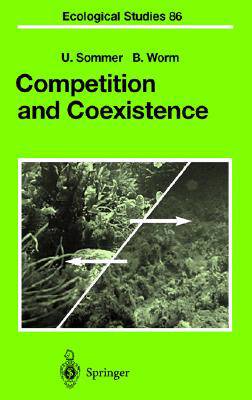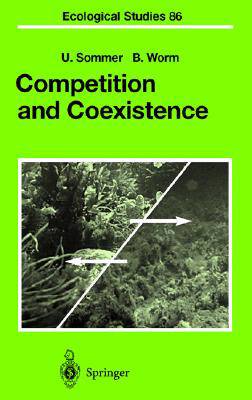
- Retrait en 2 heures
- Assortiment impressionnant
- Paiement sécurisé
- Toujours un magasin près de chez vous
- Retrait gratuit dans votre magasin Club
- 7.000.0000 titres dans notre catalogue
- Payer en toute sécurité
- Toujours un magasin près de chez vous
Description
1 Introduction.- 1.1 The Intellectual Debate Until 1990.- 1.2 Progress During the Last Decade.- 1.3 Consequences for the Structure of the Book.- References.- 2 Competition in Well-Mixed Habitats: From Competitive Exclusion to Competitive Chaos.- 2.1 Introduction.- 2.2 Competition for a Single Abiotic Resource.- 2.2.1 Growth of a Single Species.- 2.2.2 Competitive Interactions.- 2.2.3 Competition for Light.- 2.3 Resource Storage.- 2.3.1 A Competition Model Based on Storage.- 2.3.2 Storage in a Constant Environment.- 2.3.3 Storage in a Variable Environment.- 2.4 Competition for a Single Biotic Resource.- 2.5 Competition for Two Resources.- 2.5.1 Essential vs. Substitutable Resources.- 2.5.2 Abiotic Resources.- 2.5.3 Biotic Resources.- 2.6 Competition for Three Resources.- 2.6.1 Competitive Oscillations.- 2.6.2 Competitive Chaos.- 2.7 Discussion.- References.- 3 Spatial Models of Competition.- 3.1 Introduction.- 3.2 Implicitly Spatial Models.- 3.2.1 Single Species Model.- 3.2.2 Two Species Models.- 3.2.3 Conclusion.- 3.3 Explicitly Spatial Models.- 3.3.1 Interacting Particle Systems.- 3.3.2 Point Process Models.- 3.3.3 Pair Approximation and Moment Methods.- 3.3.4 Reaction-Diffusion Models.- 3.4 Comparing and Connecting Methods.- 3.5 Underlying Spatial Heterogeneity.- 3.5.1 Reaction-Diffusion Models.- 3.5.2 Neighborhood Models.- 3.5.3 Patch Models.- 3.5.4 Conclusion.- 3.6 Competition and Coexistence.- 3.7 Future Directions.- 3.7.1 More Work on Environmental Heterogeneit.- 3.7.2 Combining Population and Ecosystem Perspectives.- 3.7.3 Competition for Light Among Terrestrial Plants.- 3.7.4 Evolution and Community Assembly.- References.- 4 Competition and Coexistence in Plankton Communities.- 4.1 Introduction.- 4.1.1 What Makes Plankton Competition Special?.- 4.1.2 The Chemostat as an Experimental System.- 4.2 Competition Experiments in Laboratory Microcosms.- 4.2.1 Competition Experiments Under Constant Conditions.- 4.2.2 Competition Experiments Under Temporally Variable Conditions.- 4.3 Experiments in Field Mesocosms.- 4.4 Tests of the Intermediate Disturbance Hypothesis by Field Data.- 4.5 Herbivory and Diversity.- 4.6 The Role of Abundance and of Seasonality.- 4.7 Conclusions.- References.- 5 Competition and Coexistence in Mobile Animals.- 5.1 Introduction.- 5.2 Competition Among Mobile Animals.- 5.3 Heterogeneity, Trade-Offs, and Competition.- 5.4 Scale and Heterogeneity.- 5.5 New Challenges.- References.- 6 Competition, Coexistence and Diversity on Rocky Shores.- 6.1 Introduction.- 6.1.1 What Distinguishes Rocky Shores from Other Communities?.- 6.1.2 Evolution of Competition Theory.- 6.2 Disruption of Competitive Exclusion: The Non-Equilibrium View.- 6.2.1 Keystone Predation and Herbivory.- 6.2.2 Strong vs. Weak Interactions.- 6.2.3 The Effects of Physical Disturbance.- 6.3 Coexistence Through Trade-Offs: The Equilibrium View.- 6.3.1 The Resource-Ratio Hypothesis.- 6.3.2 The Competitive Hierarchy Hypothesis.- 6.3.3 Intransitive Competitive Networks.- 6.4 Synthesis: Integrating the Effects of Competition, Consumption and Disturbance.- 6.4.1 Consumer vs. Resource Control of Species Diversity.- 6.4.2 An Integrated Competition Model.- 6.5 Conclusion.- 6.5.1 Unifying Competition Theory.- 6.5.2 Competition, Coexistence and the Human Impact.- References.- 7 Competition and Coexistence in Terrestrial Plants.- 7.1 Introduction.- 7.2 Competition.- 7.2.1 Resource Competition.- 7.2.2 For Which Resources Do Species Compete?.- 7.2.3 Physiological and Morphological Mechanisms of Competition.- 7.2.4 Competition Summary.- 7.3 Coexistence.- 7.3.1 Neutral Theory of Biodiversity.- 7.3.2 Spatial Heterogeneity.- 7.3.3 Competition-Colonization Trade-Off.- 7.3.4 Temporal Variability.- 7.3.5 Additional Trophic Level.- 7.3.6 Multiple Mechanisms of Coexistence and Limits to Diversity.- 7.3.7 Coexistence Summary.- 7.4 Conclusion.- References.- 8 Synthesis: Back to Santa Rosalia, or No Wonder There Are So Many Species.- 8.1 Trade-Offs.- 8.2 Disturbance, ...
Spécifications
Parties prenantes
- Auteur(s) :
- Editeur:
Contenu
- Nombre de pages :
- 240
- Langue:
- Anglais
- Collection :
- Tome:
- n° 161
Caractéristiques
- EAN:
- 9783540433118
- Date de parution :
- 01-12-02
- Format:
- Livre relié
- Format numérique:
- Genaaid
- Dimensions :
- 165 mm x 240 mm
- Poids :
- 566 g

Seulement chez Librairie Club
+ 366 points sur votre carte client de Librairie Club
Les avis
Nous publions uniquement les avis qui respectent les conditions requises. Consultez nos conditions pour les avis.







